Bakers in most countries make bread with various milled wheat gains. In Scandinavia, it is relatively cold, so grain-like rye is much better suited for the climate. So that means we commonly use rye flour, and most commonly in bread. This is my Danish rye bread recipe.
Here in Denmark, rye bread is a staple of our cuisine. Almost everyone eats it for lunch every day. It’s dark, it’s malty, and it’s usually full of delicious moist seeds.
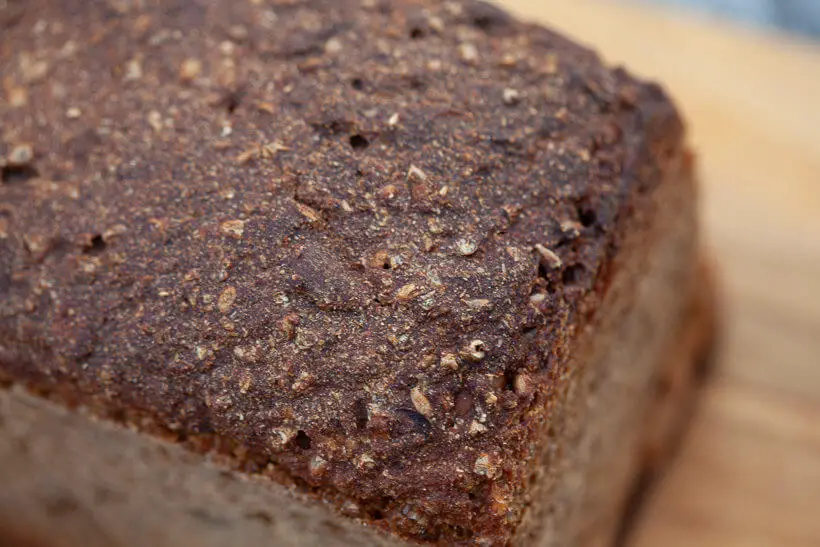
The type of rye bread is pretty different from what people in other countries think is rye bread. It’s because it’s made with 100% rye flour, whereas in most other places, people bake rye bread with a mixture of wheat and rye.
If you are just here for the recipe, you can press the button underneath to be automagically transported to the recipe:
Jump to Recipe Jump to VideoThe history of rye bread in Danish cuisine
The rye grain originates from present-day Turkey but came to Denmark through merchants and has been grown in Denmark for over 1000 years.
The Danish people have been baking rye bread all that time, although, in earlier times, bread was probably a lot less palatable than modern bread. This article describes it as coarse, baked using unsifted flour, lumpy, sour, and often half moldy. Yikes.
There’s even a concept called the Rye bread border. It describes an invisible border that cuts through Europe, where, below the border, people do not eat bread made with rye. I am all for expanding this border.

The health of this danish rye bread recipe
A bread with 100% rye is a whole-grain bread. It’s much healthier than your typical wheat bread. It has fewer carbohydrates, more fibers, and generally fills your stomach nicely (per calorie eaten).
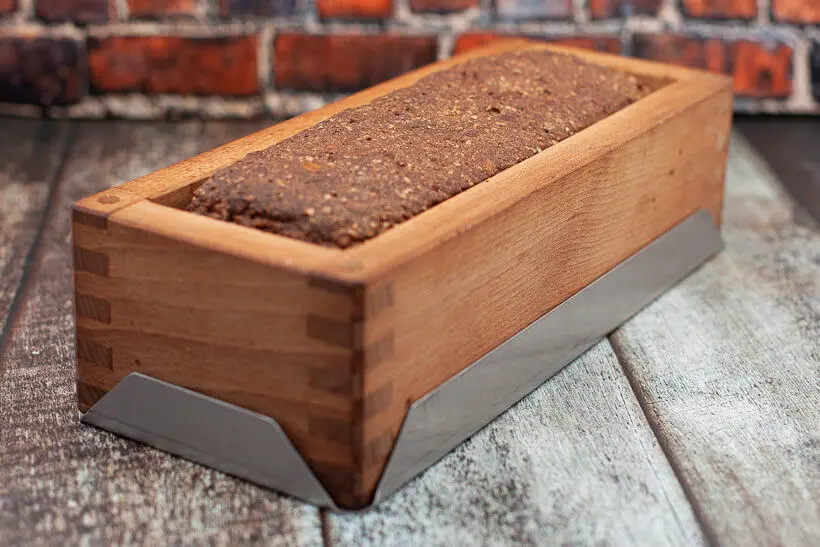
Here is a breakdown of the macronutrients of commercial white toast, commercial whole-grain toast, my Sourdough bread for beginners, and this rye bread. The rye bread may seem a bit high in fat, but that’s the good stuff from the seeds.
Judge for yourself.
| Pr. 100g | Wheat toast bread | Whole-grain toast bread | Sourdough bread | Rye bread |
|---|---|---|---|---|
| Calories | 253 kcal | 247 kcal | 220 kcal | 228 kcal |
| Protein | 7.1g | 8.2g | 7.4g | 8.5g |
| Fat | 1.8g | 3g | 1g | 4.9g |
| – saturated | 0.3g | 0.4g | 0.1g | 0.8g |
| Carbohydrates | 51g | 44g | 44g | 41g |
| – sugars | 2.1g | 2g | 0.1g | 1.9g |
| – fibers | 2.4g | 5g | 2.4g | 6.8g |
The formula in this Danish rye bread recipe
This bread requires a pretty wet starter. You can either use your existing wheat sourdough starter at 100% hydration or a 166% hydration rye starter that you’ve saved from the levain from a previous bread.
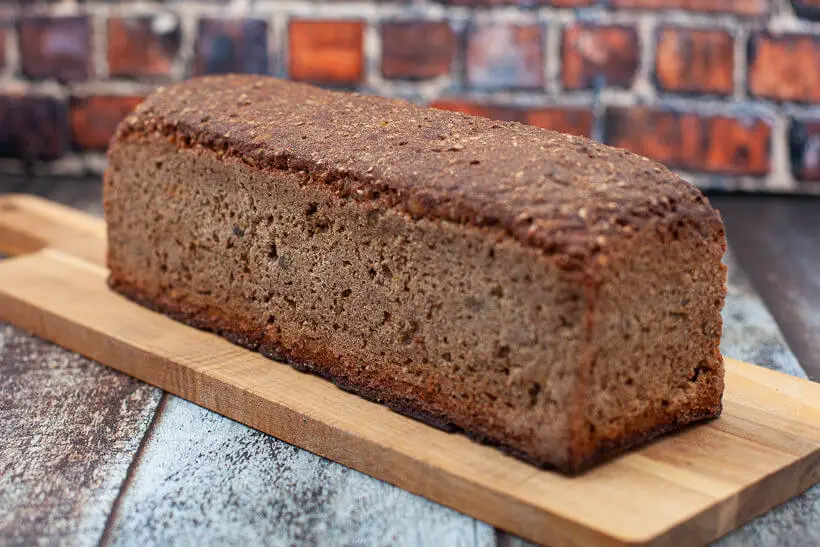
Making the levain with your wheat starter requires some extra water to get the hydration to 166%. The first time you make this rye sourdough starter (or levain), it will contain 44 grams of wheat flour from your starter. If you keep this levain and use it, that amount will fall to almost zero in 3 or 4 bakes.
| Weight | Ingredient | Baker's Percentage |
|---|---|---|
| 88g | starter (100% hydration) | 83.8% |
| 205g | water | 195.2% |
| 105g | rye flour | 100.0% |
If you use your rye starter at 166% hydration, less water is needed to keep the hydration of the levain at 166%:
| Weight | Ingredient | Baker's Percentage |
|---|---|---|
| 95g | starter (166% hydration) | 83.3% |
| 191g | water | 166.7% |
| 114g | rye flour | 100.0% |
The dough has 400 grams of rye flour and a good amount of salt. We use 500 grams of water to soak the seeds, but this does not add to the dough’s hydration. We soak so that the seeds won’t take out hydration of the dough and keep them nice and supple.
| Weight | Ingredient | Baker's Percentage |
|---|---|---|
| 200g | water | 36.4% |
| 400g | rye flour | 72.9% |
| 20g | salt | 3.6% |
| 330g | cracked rye kernels | 60.1% |
| 170g | pumpkin seeds | 31.0% |
| 50g | malt syrup | 9.1% |
If you want to play with the hydration or the formula in general, you can do it here in my bread calculator.
I don’t have/can’t get barley malt syrup. Can I make a substitute?
You can create a good taste substitute if you cannot get barley malt syrup.
Combine 125g/1 cup of dark ale and 125g/1 scant cup of dark brown sugar in a pot. Bring it to a boil, and then let it simmer uncovered until you have a very thick syrup. You can use this syrup in place of barley malt syrup.
Stored in the fridge, it stays good indefinitely.
Conclusion on this Danish rye bread recipe
This is classic Danish rye bread. It’s a staple of Danish cuisine. You will find this at any lunch and even at the celebration lunches we eat for Easter and Christmas, including other Danish specialties like liver pâté, pickled herring, and flæskesteg.
This bread is perfect for any Danish-inspired lunch. The bread has a soft crust, a dense but soft crumb, a nice chew, and a slight crunch from the moist seeds.
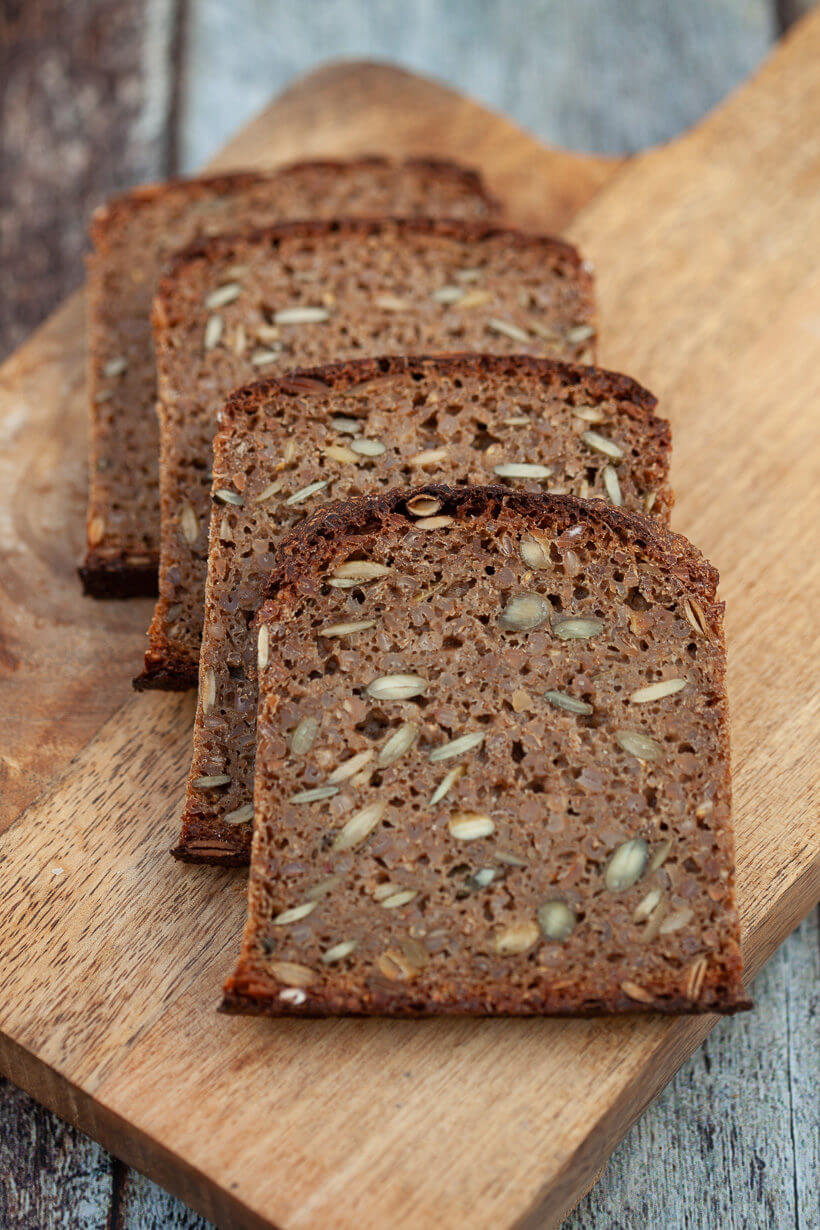
The taste is delicious. Slightly sour from the starter, but not overwhelming. A fantastic full taste from rye flour and malty notes. It’s just perfect for open-faced sandwiches.
Smørrebrød recipes – The most iconic open-faced sandwiches
There are so many different variations of smørrebrød that it is hard to list them all, but I will give you the most iconic ones that you will find in any smørrebrød restaurant in Copenhagen.
Roast beef – Rye bread, butter, lettuce, thinly sliced roast beef, remoulade, grated horseradish, pickled cucumbers, garden cress, and roasted onions
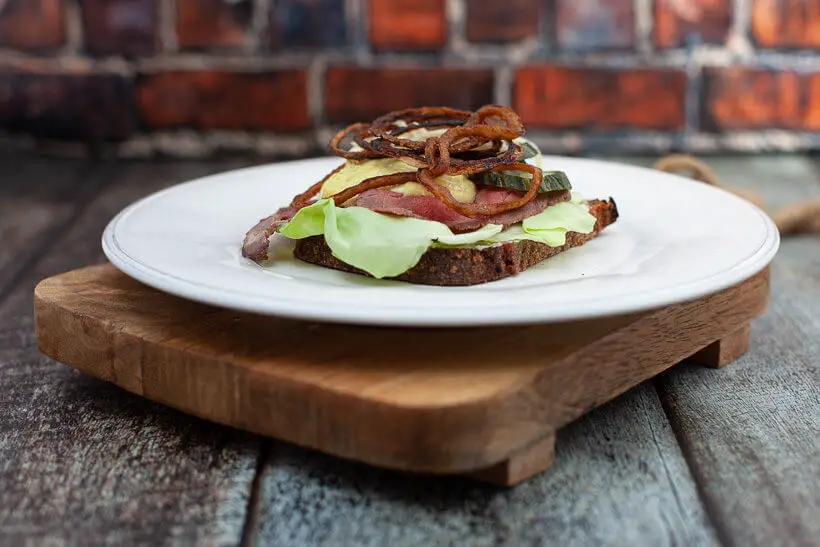
Egg and shrimp – Rye bread, butter, lettuce, hard-boiled egg, shrimp from Greenland, mayonnaise, caviar, garden cress, a piece of tomato, and top it with a slice of lemon
Fish filet with shrimp – Rye bread, butter, lettuce, a freshly seared fish filet with a rye coating, remoulade, shrimp from Greenland, garden cress, a piece of tomato, and top it with a slice of lemon
Flæskesteg – Rye bread, butter, lettuce, pork roast, crispy pork crackling, pickled red cabbage, pickled cucumbers, garden cress, and a slice of orange

Boiled brisket – Rye bread, butter, lettuce, thinly sliced boiled brisket, creamed horseradish, grated horseradish, finely chopped mixed pickle, garden cress
Ham – Rye bread, butter, lettuce, thinly sliced ham, scrambled eggs, asparagus, julienne carrots, garden cress, and a piece of fresh cucumber on the top.
Leverpostej – Rye bread, butter, liver pâté, roasted mushrooms, crispy bacon, pickled beetroot
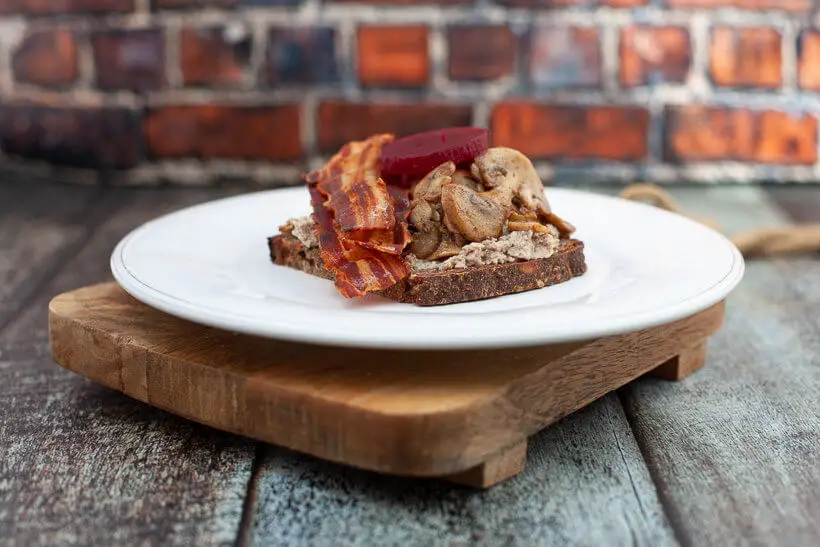
Spiced meat roll – Rye bread, butter, lettuce, thinly sliced spiced meat roll, meat jelly, onions in rings, and garden cress
The veterinarian’s midnight snack – Rye bread, butter, liver pâté, corned beef, meat jelly, onions in rings, and garden cress
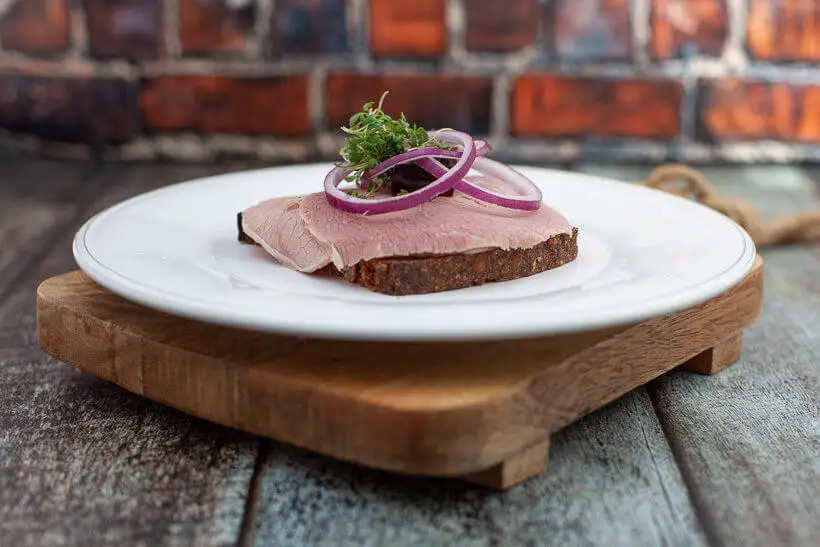
Smoked eel – Rye bread, butter, lettuce, smoked eel, scrambled eggs, garden cress, and cucumber on top
Tatar – Rye bread, butter, lettuce, minced beef steak tartare, grated horseradish, capers, chopped onion, and topped with an egg yolk
There are many more, but these are the most common ones on rye bread. There are quite a few for white bread, but that will be for a different day.
Here you can see me make four of the best open-faced sandwiches:
Please share on social media
This is my recipe for Danish rye bread. I hope you will try to bake it. If you bake it and post it on Instagram, please tag me as @foodgeek.dk so I can see your creations. That will make me happy.

Danish Rye Bread
Ingredients
Levain (using 100% hydration wheat starter)
- 80 g sourdough starter 100% hydration
- 140 g dark rye flour
- 260 g water
Levain (using 166% hydration rye starter)
- 80 gram sourdough rye starter 166% hydration
- 150 gram dark rye flour
- 250 gram water
Seeds
- 330 g rye kernels, cracked if you can't get these, use whole rye kernels but soak them even longer
- 170 g pumpkin seeds
- 500 g water
Dough
- 400 g levain
- 20 g fine salt
- 50 g barley malt syrup
- 400 g dark rye flour
- 200 g water
- soaked seeds
Instructions
Make the levain and prepare the seeds – the night before
- Mix all the ingredients for the levain; if you use a 100% hydration wheat sourdough, you should use those ingredients. Use the other ingredients; if you've keep a 166% rye sourdough from your last bake.
- There will be enough levain to save for the next bread.
- Mix the seeds with the water and leave to soak overnight.
Mix the dough
- Put 400 grams of levain, 20 grams of salt, 50 grams of malt syrup, 400 grams of rye flour, and 200 grams of water in a bowl.
- Whatever of the levain is left over is your new mother rye starter. Put it in the fridge until the next time you need it.
- Strain whatever water hasn't been soaked by the seeds and add the seeds to the bowl.
- Mix the dough by hand until everything is well incorporated.
- Butter a large bread pan liberally.
- Add the dough and level it using a wetted spatula.
- Leave to proof covered with a wet dish towel or cling film.
Proofing the bread
- A rye bread needs to rise about 30%-50% before it's put in the oven. If you put it in too early, the bread will crack on top because of too much oven spring; if you put it in too late, the bread will deflate in the oven.
- The proofing can take anywhere from 2 to 6 hours depending on a lot of factors, like the ambient temperature, the strength of your starter, the temperature of the dough, and the consistency of the dough
- A good rule of thumb for when it is ready to put in the oven is when there are 6-7 pinhead-sized holes on top of the dough.
Baking the bread
- Heat the oven to 240°C/465°F/Gas Mark 9.
- When the bread is ready to bake, put it in the oven and close the door. Bake for 10 minutes, then reduce the temperature to 180°C/355°F/Gas Mark 4.
- Bake for another 40-70 minutes until the bread's internal temperature is 98°C/208°F. Leave the bread to cool on a wire rack.
- Once it's cooled to room temperature, put it in zip lock bags and let it rest for a day before slicing into it.

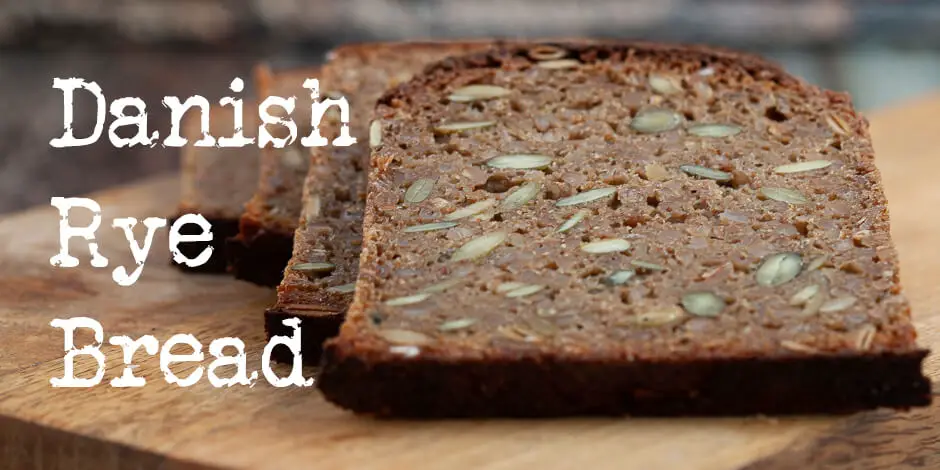


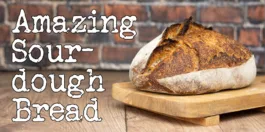
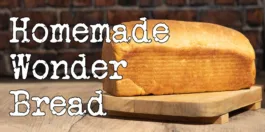

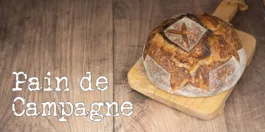
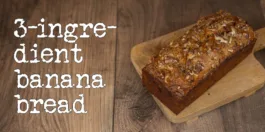
Thank you Sune. I for one am very grateful for your website and videos. What you do and that I can learn from it halfway across the world connects us as human beings on things that, in my opinion, really matter.
Thank you. It would be nothing, if nobody could use it, so I am very happy that what I make can make a difference for you.
hi Sune! Tak for your recipe. There is something unclear though… where you explain about the formula, the measurements for the levain are different from the measurements down the page in the recipe! Which one is correct? Also, if you use the 166 or 100% hydrated levain – that would make a difference in the amount of levain used in the dough (not both 400gr i assume). Hope you can answer these questions. Thank you, greetings, Sjaan
Sorry for the late reply. Somehow your message went into spam.
The reason the measurements are different is because they both turn into a 166% hydration starter with the levain. There’s enough for you to use 400g in the dough and something for a new rye mother dough 🙂
Hi Sune, great recipe. I have one question, can I replace the rye kernels for sunflower seeds?? ’cause it’s kinda of difficult to find those type of seeds in my country. Thanks in advance
The rye kernels gives it its signature feel, but sunflower seeds are delicious, so of course you can 🙂
Hello Sune, There are two parts of the recipe which I felt were not quite clear for a first-time user of the recipe (aka me). One is step 3 of mixing the dough “Strain whatever water hasn’t been soaked by the seeds and add the to the bowl.” I had to watch the video to see that any strained water would be not be used in the recipe…the words were ambiguous, IMO. Better wording, perhaps: “Strain and discard any water that hasn’t been soaked up by the seeds. Then add the seeds to the bowl.”
Two is the dimensions of the loaf pan. The only reference I could see in the recipe was to a “large bread pan”. The related video of the bread does not offer loaf pan dimensions either. What are the dimensions of the beech wood loaf pan you use?
Finally I see a link below the video to a pan on Amazon with dimensions: “USA Pan 1.5 Pound Loaf Pan measures a full 10 x 5 x 3 inches”…which equals 150 square inches. I used a pan 12×4.5×3.125 inches = 168.75 square inches, yet it seemed too small for all the dough? I was concerned how much the dough might rise, so I put a portion of the dough in a mini-loaf pan; otherwise I think the dough would have almost filled my large loaf pan.
I’ll let you know how the bread comes out! It’s proofing now. Thank you!
That’s a good point. I’ll update the recipe.
The wooden pan I use is 28 cm x 8,5 cm x 8,8 cm. About 11 inch x 3.5 inch x 3.5 inch.
The dough doesn’t rise a lot. Maybe 25% or so.
Hello Sune !, Thank you for recipe. I try to make the bread, replacing rye kernel with hazelnut and walnut, it turn out nice.
I think there is a lot of room for improvement on my first trial. I did remove the bread when the internal temperature reached 98 degrees celcius, but i notice the tip of the thermometer was covered with a little gummy bread. That’s maybe the reason why it looks a little gummy. Do you think next time i should cook it until the tip of the thermometer comes clean ?
You’re welcome 🙂 That sounds delicious 😀
How long was it in the oven to begin with? What size pan did you use? Did it rise during bulk? How long was bulk? Ambient temperature? 🙂
Hi Sune,
Excellent website and videos!
How long does your rugbrod keep? I seem to recall my aunt keeping hers in the refrigerator. Is that OK?
And can it be frozen without too much loss of flavour and texture?
Thanks!
Chris
It keeps fine for 3-4 days if wrapped in plastic. I will often keep a piece for the next couple of days and the rest I slice and freeze. Than I can take it out piece by piece and defrost in my toaster 🙂
Hi,
I’m so happy to find your recipe. I’m just starting to bake bread and hopefully will see some success.
One question regarding the recipe, is malt syrup absolutely necessary? Is it okay to omit or substitute? I have to limit my sugar intake ):
Thanks again!
The malt syrup is for flavor, you may be able to change it out for anything malt flavored. I’ve sometimes made it with malt flour.
There’s so little syrup that it’s negligible in a slice of the bread. I am a diabetic myself.
Thanks for your recipe and video! I am inspired to make a rye starter, as I have been trying to make this bread using online recipes that use yeast, and the results have been OK but not great.
Question: What would you suggest if I wanted to play around with the seeds that I use, e.g., flax, sesame, sunflower.. Just keep the weight the same as the pumpkin seeds?
Also, the Danish 100% rye that you can sometimes find in the US often has caraway (like the rye make with wheat here) – traditional or no?
Keep the weight the same, yes! 🙂
Caraway seeds are not traditional in Danish rye bread. At least I’ve never tasted it. Traditionally we use it in pretzels, cheese (caraway cheese is delicious!) and snaps, which is a form of strong liquor.
Hi Sune,
I have experienced that some bites of my sourdough rye bread are intensively bitter with quite persistent after taste. Have you ever experienced that? My only reasonable explanation is that it’s caused by the flax seeds going rancid couple of days after baking. But I am not sure. The flax seeds, and all other seeds I am using are always fresh.
Thanks for any advice!
Vladka
I never tried that, but rancid seeds are generally not very nice to eat, so that I a possibility. I’ve also heard of people having odd tasting rye bread from using not very fresh rye kernels.
I have now made this recipe 4 times and it is delicious, filling and wholesome. Cracked rye kernels are hard to find here in New England so I tried to “crack” them myself with a blender. It did not work very well, ending up with a mixture of whole kernels and rye flour. As an alternative I am now using steel-cut oats. The final loaf has the same consistency as it had with the partially cracked rye kernels, is a little less sour but is delicious with a nice chewiness to the crumb
That’s a good alternative, thanks 🙂 I will pass that on to other people unable to find cracked rye kernels 🙂
Hi Sune.
First of, thanks for your efforts in putting up this blog and videos. Great stuff!
I am a bit confused about the calculation for the regular started levain… The recipe calls for 125 gr starter at 100% hydration which if I am correct consists of 62.5 gr flour and 62.5 gr water. If we add the other ingredients I am getting
150+62.5 = 212.5 gr flour
350+62.5 = 412.5 gr water
So the ratio is almost 2, or 200%
Isn’t it so?
I’m asking because I started the recipe and the levain send very liquid…
Thanks!
You are absolutely right. I recalculated it and you need to use 210 grams of rye flour. I updated the recipe.
What is that bread pan you baked in? I’m from the US and we don’t have any wooden bread pans like that. Do you have a link where I could get one?
The company is called Aurion.
This is the pan: https://www.aurion.dk/produkter/boegetraesramme.aspx
This is their contact page: https://www.aurion.dk/kontakt.aspx
I haven’t found any place that sells it that ships out of Denmark, but maybe they can help.
Hi Sune, thanks a lot for this great recipe and all the videos you are doing. I have learned a lot from them! I have made this bread now a few times, it tastes great. However, often, it comes out slightly crumbly, especially at the top and center of the loaf. Have you experienced this as well? Any remedies? Also, for other people struggling to get cracked rye kernels, I have been using whole kernels but let them soak for longer, that has been working fine for me.
What kind of rye flour are you using?
Great with the kernels. I’ll add it to the article 🙂
This website and your youtube channel are both really great sources for bakers, specially for sourdough bread bakers. Thank you for that! I’ve made a similar rye bread recipe many times before. BTW are Rugbrød and Smørrebrød the same? For readers in the US something called “rye chops” is available from King Arthur Flour online. Also, if you happen to have rye berries just put it in the food processor for a few seconds to chop it up. I do the same with oat berries to make steel cut oats. I can’t wait to give this particular recipe a try. I have everything I need, TIME including! 🙂 Happy baking Sune!
Thank you <3
Rugbrød is the bread. It literally means rye bread.
Smørrebrød are the open faced sandwiches. Smørrebrød means buttered bread.
Hi Sune, replying to your question about the rye flour this way, as nothing seems to happen when I hit the ‘reply’ button. Where I am currently located, there is only 1 type of rye flour available, its finely ground and it says rye flour on it, that’s all the info I have… Cheers, A
Hi Sune!
I baked this bread some days ago, but I had to have it inside the oven for almost two hours. It turned out very good though, but cant understand why? I turned the degrees down to 180 after 10 minutes.
I also have a question about the Levain because I converted mine from a wheat starter which was very active when I fed it with rye, but it doesnt really rise anything at all. It gets some tiny bubbles inside, and some bigger on the top. Is the rye starter supposed to rise as much as the wheat starter? Thank you for so many great recipes 🙂 Sofia
Maybe you should get an oven thermometer to check if your oven is heating correctly.
About the starter, that sounds weird. If you wheat starter is still active, I’d try to convert it again. Rye is normally more active than wheat.
I’ve just attempted Danish rye bread following an IKEA book recipe 😉 So far so good, but it didn’t really accommodate troubleshooting. Glad that I found your website. The bread was rising in the final proof until it touched the kitchen towel and collapsed slightly. I wasnt sure what to do next, and as I was afraid the sourdough was getting tired I put in the oven. It then cracked on top 🙁 What would you advise to do in a situation like that? Leave it to rise again? (Would it rise again?) (Glad that I found your website, I’ll be using your recipe next)
You answered your own question. If it cracked it wasn’t done proofing.
I look for 5-6 of these tiny pinhole sized holes on the top of the dough. Then I bake 🙂
hey thank you we just made this danish rye loaf, I’m half Finnish living in England so struggle to find good dark rye bread. This is so yummy! we didn’t have malt syrup or rye kernels so swapped with maple syrup and sunflower seeds and its perfect. it’s so squidgy and moist weve just been eating it with butter for breakfast, doesn’t need anything else! thanks for your great tips, weve been enjoying making sourdough during lockdown with the kids, a science lesson about fermentation! any tips for sourdough pizza?
Yes yes yes. Love rye bread <3
Great that is working like a charm for you.
I will soon have a sourdough pizza recipe coming out.
Hello Sure. Thank you very much for this recipe and all your videos. Really helpfull.
I tried the rugbrød with your recipe and came out really good. Replaced rye kernels with buckwheat grains. I’m trying to get the Rye for my next bread!!
What i,d like to achieve is some flavors I tasted in other rye breads that are missing in my first try.:
more sour: I’d like it to be more tangy and soury. Should I change the rye starter? Another fermentation method ?
flavor and color: how can I achieve a more dark, moist and dense interior, with pronounced nutty flavor? More malt ? Whole rye flour?
Thanks again. Cheers !
You should use whole grain rye flour (the coarse kind) for this bread. It gives you more of those flavors you are looking for.
The color should also be darker, but you malt syrup should be what’s giving you the color.
Thank you very much for this fantastic recipe. My bread just came out of the oven and I can’t wait to cut it, see the crumb and taste the first slice. I had a lot of fun baking it and the experience gain is huge!
You said the dough will rise 30-50%. I find it difficult to guess percentage of volume, especially when dealing with different pan shapes. Can you give a rule of thumb, like “leave x cm headspace”? It’s because when I noticed that my pan is 1 cm lower than yours it was too late, the dough was already overflowing on the baking tray. In the end, I guess, I didn’t exploit the oven spring that a higher pan would have given. Also my pan’s sides aren’t parallel but conical which might roughly even out, but I wonder if it influences the final result.
How would you approach this? Scale down the ingredients or find a congruent pan? Would it work in any pan no matter the proportions, e.g. quadratical footprint, as long as the volume fits or does it for some reason need to be elongated?
What I do is put it in a clear plastic container with straight sides. Then I mark the top of the dough with a white board marker and I can easily monitor the growth quite precisely 🙂
Hi Sune,
Have you ever try to let the dough rise in the refrigerator over-night?
I am wondering whether that could give good results in terms of flavor and texture…
I never tried it with this bread, but it can be done with any sourdough bread. Rye is a bit temperamental when it comes to fermentation time, so it might be tricky to get right. Give it a go and see. Still look for the tiny pin sized holes on the top before baking.
Hi Sune and other bakers around the world. I live in Belgium. Yesterday I decided to give this recipe a second try after a first success. Again I didn’t follow the recipe into detail, here are my trial and errors. First time I decided to autolyse the rye flour in a separate bowl at the same time as the cracked rye kernels and pumpkin seeds. Next day this autolysed flour was almost impossible to mix with the other ingredients. Took me an hour to try and dissolve the lumps of strong ‘dough’. And still some remained in the final bread. I replaced half of the pumpkin seeds by pistachio this was a good idea, I lowered the amount of salt. Yesterday I made the Levain and noticed that after 5 hours he was so active that I didn’t want to risk him fall inn during the night. So I mixed all ingredients and put it it the fridge for the night. This morning I saw a nice rise in the bowl of more or less 20%. I put the dough in the baking tin and left it at room temperature for 3 hours and noticed the 6 holes in the surface so baked. It looks great, can’t wait to taste 🙂 Do you all leave the Levain at room temperature overnight? Thx for the great work and recipes. Kurt
Great that you are having success with changing the method around, there’s more than one way to skin a cat 🙂
I really stopped using levain right now, but when I do I am not fussed with it falling. As long as it’s less than 12 hours since the peak 🙂
My Danish Rye Bread was beautiful when I put into the oven and then it becomes flat in the oven 😢 what happened
Thanks for the recipe! I was wondering what kind of rye flour exactly you do use and if the substitution of malt sirup with sugarbeet syrup is ok. I have a “1000” type here in Germany but my crumb and crust are so much lighter – any idea what could cause this?
It’s dark whole grain rye 🙂
The reason I use the syrup is because it also “paints” the bread darker. But you can basically add 2% diastatic malt powder instead.
Great recipe Sune!
I’ve baked this three times now. I’ve greased the bread pans (I don’t have a fancy wooden one like Sune) with butter, olive oil, and coconut oil respectively. The butter gave the best (in my opinion) crust and super easy removal from the pans. The other’s … well, not so much. The crust wasn’t as nice and removal was very difficult. I’ll stick with butter (lucky pun!).
My vegan neighbour will just have to make their own rye bread … or go vegetarian.
I love butter, so I am with you 🙂
how would you alter the proportions to get 100% rye bread but no seeds/grains as the addition?
I’d just remove the seeds, but scale the recipe up to the same weight 🙂
Hi Sune,
I made your rye bread for a Swedish neighbour of mine. Impossible to find rye kernels so I used a combo of – farro, wheat berries, pumpkin seeds and sunflower seeds. I ran the farro and wheat berries through my coffee grinder to break them up a bit and let it soak for 24 hours. Not like your rye bread to be sure but it was an amazing bread. Everyone who tried it loved it. Am writing this so people will know that the seeds/grains can be adapted to what’s available in their area. (I am in Canada)
I so enjoy your videos and they have taken me on quite the sourdough journey. Thanks for taking the time and making the explanations so thorough. Much appreciated.
Thanks for all your work on the recipes and explanations, I love it!
Still, I’d like to offer a correction on your rye bread border: Austria is on the wrong side of it. All classical household breads have some rye, and even 100% rye sourdough bread is a classic available in any larger supermarket, bakeries anyway. Maybe the Wikipedia sources just happened to check only the 90s, where for whatever reason rye bread was indeed relatively expensive and more rare.
Alright. I actually live in Austria for a year from when I was 5 yo 6 years old.
Back then we couldn’t get any rye bread, and we missed it alot. But that is also many, many years ago 🙂
Hi Sune, I am going to bake this bread for the first time! Everything is ready for it but, I have just an issue: I only found rye flakes instead of cracked rye kernels. Ca I still use that in the bread? Thanks a lot for your answer!
Hi, thanks so much for the recipe! I have been wanted to make this type of bread for a long time. Two questions…I have a 100% hydration rye starter, should I convert it to 166% before making this bread or use the instructions for the wheat starter? Also, do you have any experience baking this in a larger pan? I have an American Pullman loaf pan (33x~10x~10 cm) and I’m worried it might be too squat if I don’t scale up on the amounts. Thanks for any advice 🙂
Hi Sune, thanks for your previous reply! I was wondering if you could recommend an online-shop selling these baking frames? In Germany the sizes are different, also there are none with a metal bottom available. Would highly appreciate any recommendation! Best regards, Andrea
Perfekt rugbrød for første gang! Både konsistens og smag. Brugte min “half´n half” rug/hvede-surdej. Tak! M.
Where did you get that wooden bread mold? Can I buy one of those online somewhere? AND who makes the cast iron baking “dish” that is in the chocolate sourdough video? Thanks!
Hi Sune,
Thanks for the recipe! Can’t wait to try it!
One question: for your bread calculator, what type should I enter malt syrup under? Is it fluid, sugar or other extras?
Many thanks.
It’s an extra. I’d put it under “Other extras” 🙂
I couldn’t get the “reply to comment” function to work, so I am adding a general comment.
Andrea was asking about her bread being much lighter. The malt syrup that you’re looking for in Germany is called Gerstenmaltz. I’ve been using this one https://www.arche-naturkueche.de/de/produkte/europaeische-kueche/sirup-malz/gerstenmalz, which I can find at both Vitalia and Denn’s biomarkt. I am sure there are other brands.
😲😲😲 – Austria is bellow the Rye line!
Mssrs Detmolder will be most upset.
😥
Chuckles.
Great recipe and wonderful sandwich making – So creative!
Thanks
I would love to try this. I alas am having trouble finding rye berries/rye kernels in my area. Can I substitute something else? Wheat berries perhaps? thanks
Where do I buy your wooden baking case please?
Break looks amazing. I am thinking about making but noticed that the quantities for the of the levain vary between the video, website above, and the recipe above. Can you clarify the quantities of starter, rye flour and water for levain? Thanks!
Sune, I have a 100% hydration rye starter. Should I follow the recipe as though I am using a wheat starter? Thanks!
Sune — also, do you think one could successfully substitute wheat berries for rye berries?
love yor site .love your methodological way of teaching. CLEAR,ORDERED AND FUNNY..
looking forward to implimenting all your recepies.
trying the dannish rye bread right now. though couldn’t find rye crackles. (ISRAEL….) thinking to put soaked buckwheat.what do you think?
Hello, and thank you for the Danish rye bread recipe. My husband was an exchange student in Denmark, and he says this bread reminds him of the wonderful experiences he had there. I’m wondering if this bread will freeze well?
Dear Sune, thank you so much for your amazing videos and website!! I am a complete beginner, so sorry for the stupid questions…but I have made a 100% rye starter at home (i do 200g starter then feed with 200g rye/200g water). What quantity of this starter should i use for this recipe? can i use 400g of this starter i have made after it has been fed? or should i follow the instructions of the 166% levain? Sorry again for the silly questions, i am new and this is all very confusing 🙂 Thank you again for your amazing resources!!
I’m pretty much making a new one of these every time I finish the previous one. It has wonderful keeping qualities, so if it takes a week to burn down the loaf – no big. The one change I’ve made is the pan I bake it in – I’ve been using a Chinese “oil pan” that I bought to make panettone, and bake the recipe as one big loaf. That’s a round pan made from a single piece of metal, 20cm diameter and 13cm high that cost almost nothing. Parchment round at the bottom just in case.
Hello Sune!
I was wondering where you can buy a beautiful wooden loaf pan like you are using for the loaf in your video. Thank you so much have a great week.
Hi Sune, thank you for your videos and recipes. I really would like to make this bread. I tasted it for the first time 15 years ago when my boss made it (he’s Danish) and I loved it. My Rye sourdough starter is 100% hydration so I’ll keep the same amounts for the levain as if I were using the wheat sourdough starger 100% hydration? Another question did you bake the bread in a fan-assisted Oven? Thank you so much again.
Thanks for this, Sune — I have now acquired all the ingredients, and can’t wait to back it! I’m new to sourdough, though, and have a question: When you mix up the rye levain the night before, do you leave it out at room temperature or refrigerate once it’s become active?
Hi. Is there a reason for discarding the water that you’ve soaked the seeds in our can this be used in the “main”dough?
I cannot find Malt Syrup in Canada. What can I substitute?
Hi sune
Can I replace some of the water with Guinness many ryebread recipes use beer
By the way I bake this bread every week love it just like to experiment a little
Thank
Hej Sune, thank you for the inspiring content and especially the bread calculator. It’s early morning in Jämtland right now and a rye is proofing as I type this. Love the bread, I bake it weekly though I replace the malt syrup by using a heavy, sweetish stout instead of water and I season the dough with some finely ground aniseed, fennel and caraway seed (about 8 grams total). With the old loaf almost gone, I can hardly wait for the new one to be ready for Smørrebrød!
Hey! Thanks for the recipe. Your approach to figuring out and explaining how things work is fantastic, and my failure here is very humbling 😀
So I really wanted to make these kinds of breads for a while, but I now have tried to make it twice and I have failed miserably twice.
I bought rye in the local craft beer supply shop and had them grind it to get the cracked rye.
I substituted the 50 gr of malt syrup with 50 gr honey.
The dough looked the same as the video through the entire process.
The fermentation temperature was 29-30 degrees (oh its hot here)
I tried this recipe twice and had the same problem
– on the first time I am sure I over-proofed it, on the second time it did rise well, but I only had 3-4 holes on top – it rose by like 50%.
– I baked it until I reached the internal temperature 98°CF as the recipe requires. which took like 50 minutes on the first time. On the second attempt I baked for full 70 minutes.
The result was weird and identical on both attempts.
The bread collapsed severely after baking (there was a crust with a large air-pocket under it
The inside was very wet and porridge-like / gummy. It did not taste raw, it tasted wet / pasty.
Now I am happy to use it for so much Kvass (oh so much Kvass), but I do want to get the bread right at some point.
I am not sure where to start troubleshooting this. I can use real malt syrup, and try to proof less. But I dont see how that would explain the pasty texture and the insane collapse. I would appreciate any ideas and thoughts on how to troubleshoot this one.
Here are some photos and a video of the texture from the 2nd attempt
https://photos.app.goo.gl/3w3EXR9qbnGAkqyr8
Thanks!
Sune, thank you for this recipe and videos. Very helpful. I made this today and my only substitution was a rye chops and seed mixture I bought online from a mill instead of separate rye chops and pumpkin seed measurements. It rose to the right level in about 3 hours and I baked to 208 degrees F in the center (10+40 minutes). After it cooled a little, I turned it out and the bottom was a little gummy. I think this will dry out and suspect it is from the seed mixture. Pretty confident it will taste fantastic.
Awesome recipe – my 4 mini-loaves are cooling now but I had a taste from a muffin sized extra I made. I did not have cracked rye handy so substituted flax seed.
Thanks so much for this Danish Rye sourdough video and recipe! I broke my right (dominant) arm recently and was lamenting not being able to knead and shape bread.
I discovered that I can make this recipe even with a broken arm, it’s that easy!
I did use the remainder of the seed soaking water to thin the batter to a consistency that I could manage, besides that It looked so full of good flavourful stuff!
I added the seeds last, it was as much workout as I could handle.
I felt good about this and accomplished! Thanks!
Kathryn
How do I refresh the 166 hydration starter and how often do I need to refresh
I am not sure the comments are working – I am asking if I need to and if yes how – do we refresh the 166 hydration starter?
Where can I purchase the bread pan with wooden sides in the US? Your promo partner kicks me to Amazon that does not show anything like it. Ate a lot of Danish rye and Liverwurst as a small child–still love it.
Sune, in my small city is difficult to find ingredients, But I have Malted Rye grain instead of cracked rye kernels. Also I have dark molasse syrup, instead of malt syrup. It would work? Recently I tried a finnish recipe that uses these ingredients: malt rye grains and dark molasse syrup.Not sure if there are many ways of doing this danish recipe. Thank you.
Hej Sune, Mit brød bliver klæg. Smagen er vidunderlig. Hvad gør jeg forkert? Tak for gode videoer. Mvh Maibritt. Ville skriv på engelsk men ved ikke hvad klæg er. Du må gerne svare på engelsk så det bliver tilgængeligt for alle.
This looks amazing. I want to bake it but I’m not sure what size pan to use. I have a 13 x 4” Pullman pan with a cover. Would this work? Thanks.
May I ask for some help? I love this recipe, having made it twice. Each time, however, I end up with more leftover starter than I began with. I now have about 375 g of starter in the fridge. How can I adjust the recipe so I use most of the starter up in the levain (and bread), but yet will still have some of the levain to add back into the starter to keep it going? Am I making sense? Am I over thinking it? Just pour more of the prepared levain into the dough? Would it hurt to use 500 or 600 g levain? Thanks for any advise you care to give.
Hi Sune, thank you for this lovely recipe and all your excellent work!
I read on the internet various ratios to substitute malt syrup if not in hand and I am confused. One says 1 part of malt syrup = 1/3 of molasses, the other 1 part = 3/4, elsewhere 1 part = 2/3….what would you recommend?
And can it be used honey instead or would that affect differently the sourdough? Thank you for giving us your thoughts on this.
Hello from Los Angeles! I got into your channel just after we began lockdown in March. I am wondering why my bread comes out very “crumby” and somewhat dry-ish? It is still delicious but my slices don’t come out quite as compact and neat as yours. I followed your recipe to a tee but I did notice the next day that my bread sweated in the plastic bag that you recommended. Perhaps I should leave the bread alone for a day in the refrigerator instead given that we are much warmer? I did make sure the bead was cool before placing it in the bag unless that wasn’t cool enough. Any help you can provide is much appreciated. My husband also thanks you for the channel, he is from Northern Italy and this bread reminds him of home.
Hej Sune
Mange tak for dine opskrifter, vi er danskere der bor i Hong Kong.
Just want to know if it’s possible to halve your recipe? Your recipe fills our two bageform so we keep the other loaf in the freezer but would like to know if it’s possible to just bake one next time. Mange tak!
Thank you for the recipie. I made 166% rye starter which rose very well. I reduced the proportion by half as my loaf tin is not very big 8.5″x4.14″x2.5″ inches. After 5 hours of proofing the dough I did even have one pin size hole. I baked for 15 minutes at 230degC and at 180 deg C gor 50 minutes. Also kept a 18 20 ice cubes in the botyom tray. Sadly my bread did not rise well and its gummy at the bottom. Immediately adter taking out i wrapped the loaf in a cloth and after 3 hours kept the loaf in sealed ziplock. Please let me know where i went wrong. My family loves rye bread. We live in Dubai, the current ambient temperature in the kitchen is 24 degc
Hi, Sune!
Tusind tak for alt det arbejde du har gjørt til at presentere denne opskrift for øs der ikke kan køb rubrød i supermarkedet. Jeg er halv Dansk og bor i Alabama, USA. Jeg savner brødet som jeg spidste nar jeg besøgte min familie i Denmark, og glæder mig højt til at spise det igen. Jeg kan køb Mestemacher på Amazon, men det er bar ikke det samme. Min ovn varmer op nu, wish me luck!
This is lovely! Do you also have a pumpernickel recipe that you recommend?
Unfortunately not. I’ve never even tried pumpernickel.
I’ll look into it 🙂
Hi Sune, after trying a lot of different rugbrød recipes, this is the first one that has been perfect every time. Thank you for the recipe and video, as well as the explanations for managing different scenarios!
I have one question on managing the leftover levain (that is, my new rye starter), when I need to store it for a few weeks. What type of flour, and what amounts of flour and water do you recommend feeding a rye sourdough starter? Is there any difference between maintaining a rye starter and a wheat starter?
Sune, may I use rye chops in place of the rye kernels? Thanks so much
Hi Sune
I made this bread twice now, and wanna try to bake one with the extra levain i got from
the last two breads.
Can i just use that directly as it is (it`s in the fridge), or do i need to “feed it up” like an normal starter?
I hope you unterstand what i mean?
Hej Sune
Hvilken størrelse brødform bruger du? En “pullman” størrelse? også, er solsikke- og hvedebær ok at bruge som kerner?
Hi Sune and big up for your great baking tips,
I’m new to using seeds in bread so I wonder if the pumpkin seeds must be de-husked before or they can simply be soaked and then incorporated in the dough.
Thank you so much, looking really forward to trying this recipe!
A disposable shower cap works well to cover a bowl of rising dough.
This looks promising – there’s a lot of dough here – what size is a “large” bread pan?
Hi Sune. I live this bread so much. Thank you! At last a lovely light and tasty Rye loaf.
What I can’t perfect though is the ability to cut thin slices for open sandwiches as it’s so sticky. I usually toast it twice ( being English of course!)
Really want to use it as bread though so I can do Smorgasbords.
Also mine is rising so much it’s sticking to the wet cloth. Does it matter if it does that? Well over 7/8 pin holes. !
Thanks again.
Joe
I think you may need to bake longer. It shouldn’t be that moist. Also, do you do the 24 hours in a ziplock bag before cutting into it? 🙂
Love it! How about one with flax seeds?
Feel free to tweak the seeds to your liking 🙂
I’ve made this a couple of times now, and it’s by far my favourite rye bread recipe. Thank you for posting it.
Thank you <3
I made this last week and it was delicious! I saved the extra levain in fridge. Do I need to feed it if I want to bake another loaf? Or, can I use the rye levain straight from the fridge as is?
You should be able to use it straight from the fridge. The more sour it is, the better the flavor in the bread.
Sune, May I use rye chops in place of the rye kernels. Thanks so much
I hadn’t heard of these before, but I think they’re very akin to the cut rye kernels that I use, so I say, go for it 🙂
Hi Sune, great recipe made it a couple of times and has been perfect both times. I was wondering if you retard in the fridge overnight after the final proving? This is just a convenient timing thing for me as realises bread is best 24 hours after baking. Thanks Geoff
I’m getting ready to make this bread. I’m excited! On the written recipe you specific 225 g rye flour for the levain, but in the video you say 150. Would you clarify please?
Don’t worry, it’ll be fine, your bread will be fine.
I’ve updated the amounts in the recipe since they were not completely correct. It isn’t completely correct in the video either, but if next time you use what’s in the written recipe you will be left with 80 grams of starter that you can use for your next rye bread 🙂
Sorry, not 225 but 210. I already made the levain with 210 g of rye flour. If the video is correct , could you tell me how to fix it tomorrow when I make the dough?
Hi Sune, can you please explain what you mean by 100% hydration for wheat starter, and 166% for rye? I use a rye sour dough starter. I have never heard of hydration associated with sourdough starter.
A 100% whole-grain rye starter will be very stiff, so it’s used at 166% hydration to ease maintenance. If your starter is made from equal amounts of flour and water (by weight), just proceed with the wheat starter (although it is wheat) 🙂
I’m looking for a recipe for leverpostej. Do you have one that you prefer?
Hello Sune! Thank you for this delicious recipe. I have made it about 5 times now, and although we absolutely love the flavour, It always comes out flawed. The top and sometimes part of the side crust, separates from the rest and also the middle part of the bread is usually so wet, that it crumbles.
I really don´t know what goed wrong. I´m quite an experienced bread baker, but I can´t seem to figure it out with this one. Because the top collapses somewhat, I thought I may have fermented it for too long, but it has never fermented more than 40% in volume and I always look for the proper amount of ‘pinholes’. I also always temperature in the middle, so I´m absolutely sure it´s thoroughly cooked. Do you have any idea why this bread keeps crumbling down on me and why the crusts separate?
Hello Anna,
It sounds like you may not be using full-extraction rye flour. Is it called whole-grain or dark rye?
If you can’t get any other rye, I’d recommend lowering the hydration. It sounds like it’s over-hydrated.
With regards to the crust separating. Do you let the bread rest for 24 hours before cutting into it? I know it’s hard to wait, but this time is essential for rye bread.
Love,
Sune
Hello! How long do I need to soak whole rye kernels for?
Half an hour should do it 🙂
Thank you for this wonderful recipe and website, Sune. Where can I get a bread baking pan like the one you use for this wonderful Danish Rye Bread?
You’re welcome 🙂
It’s made by a Danish company called Aurion. I’ve asked them; they don’t mail internationally and are not particularly interested in it.
https://www.aurion.dk/forme–47/boegetraesramme-2-l–911902
https://www.aurion.dk/forme–47/staallaag-bund-rustfrit-til-boegetraesramme–911903
Hi Sune,
I would like some advice.
I have been trying to make Danish rye bread and I have a problem with 1) too moist crumb (really gummy – sticks to the knife and balls up when I slice) and 2) fault or separation between crust and crumb so it falls apart when I slice.
I tried baking longer (that didn’t help at all), reducing the hydration (that helped a bit but not enough)…
My problem is, unfortunately, probably multi-factorial. I live in France so I can’t get cracked rye. I have been sprouting whole rye kernels as an alternative, but they do not behave the same way. Also my rye flour is certainly different from yours.
Any ideas for trouble-shooting the gummy crumb and crust-crumb separation?
Perhaps for the crust-crumb separation I am not proofing long enough??
I recently purchases a bread pan with a lid but that did not solve the problem either.
I bake ordinary sourdough bread all the time, so I sort of know what I am doing…
I would be grateful for any comments.
Hello Jacqui,
Both of those problems, gummy crumb, and top separation, usually happen when you underproof your dough, so you may want to extend the time that you proof 🙂
Sune
thank you so much. I will try to proof longer. My dough usually rises about 25% before I bake, as estimated from height in the bread pans, but the crumb and top separation are persistent problems. I will try proofing overnight in a cold place. I have not done that yet for my danish rye. Also I notice that you bake without the lid on the pan. I have tried wit and without, and that didn’t help much either. Any thoughts on the advantages/disadvantages to the lid?
I will continue to experiment and I will get some cracked rye in a month or so when I get visitors from Denmark and that may help.
It took me a while for my sourdough wheat bread to be reliably and repeatable good too but I have that one now :-))
I use the “pinhole method” for determining the proofing. When 6-8 pinhole-sized holes are on the top of the bread, it’s ready to bake. It works every time.
For me, the lid is for sandwich bread. You don’t want to hinder the growth of rye bread 🙂
Hi Sune! When I make the levain the night before, should I put it in the refrigerator till I’m ready to make the dough, or should I leave it out on the counter at room temp?
Leave it out on the counter 😊
Thank you for the fast reply, Sune! I made the recipe, and loved it! I didn’t have barley malt syrup, so substituted molasses in addition to 2% diastatic malt powder (I added the diastatic malt powder when I made the levain). The dough filled my 9×5″ loaf pan to the brim, and still had more dough so I put the rest of the dough into a mini loaf pan (about 3 x 9.5″), almost to the brim. For both pans, the dough started overflowing the edges of the pans by the time it finished proofing, and continued to overflow in the first part of the cooking. I’m not sure if the diastatic malt powder had anything to do with this overflowing problem – what do you think? To be safe, next time I’ll fill the pans to about 4/5 of the way to the top, and put the extra dough in another mini loaf pan. The bread was delicious, and I plan to make it again! Next time I will try using the barley malt syrup for the extra aroma it will add. Thank you for this wonderful and easy recipe!!
Thanks for this great recipe and tutorial. My kid is in Copenhagen now, coming home soon to the US and requesting Rugbrod and Smorbrod on her return. Im an experienced sourdough baker so Im good on the starter, levain, formula, etc. I got a pullman loaf pan ” 33x10x10cm. Wondering about the size of your pan so I can adjust to fill my pan properly. THanks for your help!
Hi Sune! I am getting ready to make your Danish rye bread recipe for the 2nd time. I enjoyed it greatly the first time, and this time around, I found barley malt syrup that I look forward to using. I have a question: I plan to use the leftover 166% hydration rye starter that’s been sitting in my fridge for about 6 weeks since the last time I made your bread. Do I need to feed the starter first to make sure it’s active and bubbly, before using it for the levain in step 1 of this recipe? Thanks for your insight!
I love rye bread, but I am having a constant difficulty with flying crusts. I followed the recipe exactly for a 100% wheat starter. I baked it at about 40% rise and still had the same problem. Most Danish rye recipes I have see follow these steps, so it’s definitely a me problem! Any suggestions? Thanks.
Try this: Look for about 8 pinhole sized holes on top of the bread as a measurement for if it is done proofing.
Hello, Sune;
I am writing from America; from Minnesota where there are many Scandinavians like my husband! I love rye bread and I think my husband would love it too if he tasted the real thing. I have found your recipe and a good recipe from the New York Times, but I’d like to use yours because it starts with an established levain which I have.
I’m just confused about how your recipe is written. All I have on hand is an established sourdough starter without rye flour (just bread/strong flour).
My questions are, am I supposed to use both levains that you list in the recipe or am I supposed to choose one based on the hydration I want to use
Secondly, I am not used to the hydration being listed for starters. What does 100% and 166% hydration mean when you list it in the ingredients? I watched a couple of your videos on sourdough starters, but I’m still not clear on what the percentage of hydration actually is.
So if you could just explain the levain part of your recipe I think I can make it from there.
Last question – is pumpernickel flour, the same thing as rye flour? And can pumpernickel be used as a substitute for rye?
Thank you for taking the time to consider my questions!
Marla Helseth
Tak for opskriften. I’m a dane living in Australia and this is the first bread I’ve ever baked that had the moisture of a real Danish Rye Bread. Simply delicious! Just one question- when I make the levain I end up with less every time. It means this time I only have 45 grams. I’m guessing I need to feed it but not sure how to. Can you please assist?
Hello, Sune; Thank you for this recipe! I love Danish Rye bread and love baking. I have begun this recipe yesterday and look forward to the results! I have a question: You say in the recipe that if you use rye berries you’ll need to soak them longer. That’s what I’m using and it’s been almost 24 hours and the water is not all absorbed yet, so I will soak the berries and pumpkin seeds longer. My question is, what should I do, if anything, to the levain while the seeds are still soaking? Should I remove some of the starter and feed it? Or is it okay to leave it on the counter another day if that’s how long it takes for the seeds to absorb all the water? Thank you!
Hi Sune, thanks so much for the recipe, it tastes amazing! My only issue is the inside too wet- upon slicing, some wet dough remains on the knife blade. For my second attempt I reduced the water in the dough by 15%, but same result. Any suggestions?? Thanks.
Do you let it rest 24 hours before slicinh into it?
Your rye flour may be too ‘fresh’. To replacing 15% of the water with buttermilk or letting your starter ferment so long that it’s more acidic.
Thanks for the fast reply. I only waited about 13-14 hours before slicing. Next bake I will wait 🙂
My levain had fermented for about 20 hrs prior to mixing. It’s summer here and my starter/levains are very active.
You’re welcome. Make sure it’s pretty sour too 🙂
Should the bread be cooled in the pan? I kept it in the pan on a wire rack for a few hours while it cooled to room temp and now the bottom is very damp. I’m unsure if and when to put it in a ziplock. Any advice?
Thanks Sune for this bread method. It’s now my go-to rye bread, replacing the one from Stanley Ginsburg’s “The Rye Baker”. I’ve made it several times now, trying to address the issue of the rye berries being too hard, even after a long soak, and even after my attempts at cracking them. Neither my blender nor food processor did a very good job of cracking. My second-to-last time, I tried soaking the rye berries for 24 hours, adding the seeds before the overnight soak, but they were still too hard. This last time, I substituted millet, which worked well.
After all this experimentation, I realized that what would make the most sense would be to cook the whole rye berries in water until they are somewhat tender. The next experiment.
My other modification is to the pre-ferment. Since I keep 105g of 100% hydration starter in my fridge, I found that building the pre-ferment with 67g of starter, 116g of rye flour and 216g of water gave me the precise amount of preferment. Then, I just replaced the 67g of starter with a 50-50 mix of flour and water. Since I use the starter at least once a week, that seems to work well.
Finally….I don’t wrap the loaf in plastic for the after-baking rest. I found that this, like all sourdough breads I make, keeps well cut side down on my cutting board, for at least a week. After a couple of days, I toast it, and if it gets too difficult to slice, slice the rest and put in the freezer.
Thanks again for doing these experiments for us!